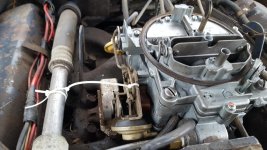I had a thought last night as I was going to sleep. I know that back when I had a shop working on this I had them tie the choke fully open.
I was entertaining a "what if" scenario in my head last night and thought "what if" as I increase the thottle the choke plate is falling down to the closed position until I back off the gas and press it again to raise it back open?
I recall them telling me the auto-choke wasnt working, and when it was zip tied it simply wouldnt run. BUT I'm thinking what if I zip tied the choke, not so its fully open, but only so it cant fully close, say tie it so it can only get 1/4 closed or so.
I figured once I get good and warmed up, I can shut off and apply the ziptie with some slack, then drive around a bit.
This way if my issue changes from complete choking to just a loss of power due to it only partially closing I can isolate for sure if its choke related.
Granted I'm no expert yet with the carb, but its something I was thinking about, this is something I can test first without having to dismantle anything.
If this test is unfruitful then I can take off that switch and have a look (probably want to do that either way though).
Does this make any sense or am I talking nonsense?
I was entertaining a "what if" scenario in my head last night and thought "what if" as I increase the thottle the choke plate is falling down to the closed position until I back off the gas and press it again to raise it back open?
I recall them telling me the auto-choke wasnt working, and when it was zip tied it simply wouldnt run. BUT I'm thinking what if I zip tied the choke, not so its fully open, but only so it cant fully close, say tie it so it can only get 1/4 closed or so.
I figured once I get good and warmed up, I can shut off and apply the ziptie with some slack, then drive around a bit.
This way if my issue changes from complete choking to just a loss of power due to it only partially closing I can isolate for sure if its choke related.
Granted I'm no expert yet with the carb, but its something I was thinking about, this is something I can test first without having to dismantle anything.
If this test is unfruitful then I can take off that switch and have a look (probably want to do that either way though).
Does this make any sense or am I talking nonsense?












